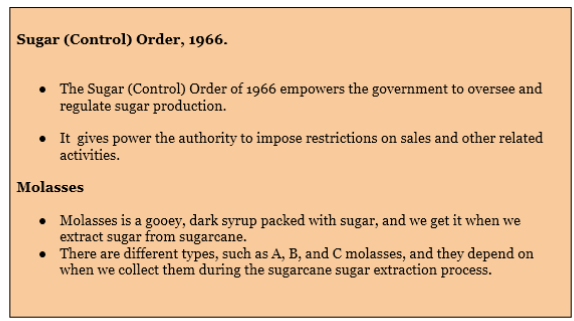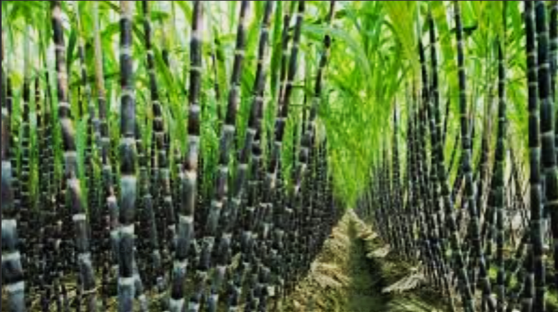GS Paper - 1
Why in the news?
The Indian government recently implemented an immediate ban on the utilization of sugarcane juice or sugar syrup by sugar mills and distilleries for ethanol production.
- This directive, executed under the Sugar (Control) Order, 1966, is a temporary measure designed to ensure a sufficient supply of sugar for domestic consumption.
- The objective is to stabilize sugar prices and meet the current demands within the country.
Note: It is noteworthy that the government may reassess and potentially revise this decision in response to the evolving conditions of the sugar market.
Key Points:
- The government has approved the use of 'B-molasses' for ethanol production in the fiscal year 2023-24.
- Maharashtra, contributing 30% to India's ethanol production, is expected to be significantly affected by this decision.
- Oil marketing companies are now mandated to rely on B- and C-heavy molasses for ethanol blending.
- This shift in raw materials signals a change in the traditional practices of ethanol production.
- The move has the potential to impact the dynamics of the ethanol industry, requiring stakeholders to adapt their strategies accordingly.
Status of sugar market Condition
- Indian Sugar Mills Association (ISMA) anticipates a 9 percent decrease in gross sugar production for the 2023-24 marketing year, estimating a total of 337 lakh tonnes.
- In the 2022-23 marketing year, sugar exports from India declined to 61 lakh tonnes, contrasting with the previous year's record of 112 lakh tonnes.
- The government has not yet authorized sugar exports for the ongoing marketing year.
Note: It's important to note that, in addition to sugar, the sugarcane industry yields other byproducts such as cane tops, bagasse, and filter muds.
What is ethanol?
- Ethanol is a renewable fuel.
- produced from various plant materials,
- collectively termed "biomass."
- It is generated through sugar fermentation by yeasts or petrochemical processes like ethylene hydration.
- Widely used, with over 98% of U.S. gasoline containing some ethanol.
- E10, a common blend, consists of 10% ethanol and 90% gasoline.
- E85 is another available ethanol blend.
Uses:
- It finds application in the medical field as an antiseptic and disinfectant.
- Its usage extends to being a chemical solvent and playing a role in the synthesis of organic compounds.
- It serves as a biofuel, functioning as an alternative source of fuel.
Initiatives to promote the production of ethanol:
- The 2018 National Policy on Biofuels aims to increase biofuel availability and boost blending percentages.
- The Ethanol Blending Program targets a 20% ethanol blend in petrol by 2025-26.
- PM JI-VAN YOJANA provides financial support for second-generation ethanol projects.
Impact of Government Banning on "Sugarcane Juice and Sugar Syrup" for Ethanol Production on Sugarcane Industry
Potential Impacts on the Sugarcane Industry
Positive Impacts:
- Increased Sugar Availability:
- The ban is expected to make about 2.5 million tonnes of additional sugar available in the domestic market, potentially leading to lower prices for consumers.
- Reduced Surplus:
- The estimated sugar surplus for the season may be reduced to around 4 million tonnes, mitigating the risk of oversupply and further price decline.
- Focus on Sugar Production:
- Sugar mills may now focus on maximizing sugar production instead of diverting sugarcane juice and syrup towards ethanol production.
Negative Impacts:
- Reduced Ethanol Production:
- Ethanol production from sugarcane is likely to decline,
- It potentially leads to increased dependence on imported fossil fuels.
- Lower Revenue for Sugar Mills:
- Lower ethanol production means reduced revenue for sugar mills, which could impact their financial health and lead to job losses.
- Discouragement of Investments:
- The ban may discourage investments in new ethanol production facilities, hindering the development of the biofuels sector.
- Impact on Farmers: Lower demand for sugarcane for ethanol production could lead to lower prices for farmers, potentially impacting their income and livelihood.
Additional steps by the Government
- To control food inflation, the central government has implemented a ban on the export of wheat and broken rice.
- Additionally, a minimum export price (MEP) has been set for basmati rice.

Source
https://afdc.energy.gov/fuels/ethanol_fuel_basics.html

